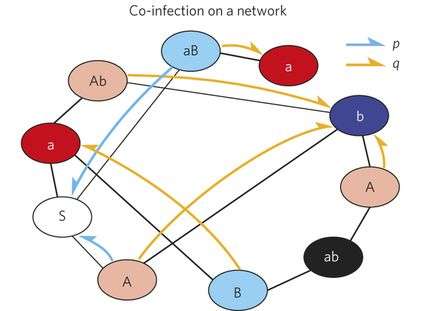September 18, 2015 report
Modelling the dynamics of avalanche outbreaks

(Phys.org)—The 1918 outbreak of Spanish flu was so unlike other pandemics that it is analogous to a massive natural disaster. The H1N1 virus infected an estimated 500 million people and killed 100 million by some estimates. And while ordinary flu outbreaks primarily endanger the infirm old or very young, Spanish flu was more likely to kill healthy young adults because it caused an overreaction of the immune system, known as a cytokine storm, which is stronger in healthy individuals. Weakened or compromised immune systems, unable to mount such strong overreactions, were likelier to result in survival.
What separates avalanche outbreaks from the transitory prevalence of a contagious agent? One of the main reasons that Spanish flu was so contagious was its co-epidemic of bacterial pneumonia. While most single-agent contagion networks exhibit a continuous transition described as a "percolation transition," more violent spreading can occur when the participating agents are of more than one type. A modern example is the concurrence of HIV/AIDS with a host of pathogenic diseases including tuberculosis, syphilis and hepatitis. Recently, a group of researchers in Germany reported in Nature Physics a mechanistic model that attempts to explain contagion processes involving inter-agent cooperation.
Because it's a network model, the authors note that their findings are applicable to catastrophic occurrences in other domains, including financial contagions or cascading power blackouts. They point to a pair of influences: Positive-feedback interactions can impose instability on large systems. And the underlying network medium (i.e., a networked group of people, or of power transformers) strengthen or impair the cooperation between the interacting agents. "The outbreak profile is thus shaped by both agent-agent and agent-network interactions," the authors write.
The model reveals that cooperation can lead to phase transitions of different orders within a network—the resulting outbreaks can be either mild or abrupt and massive. And the actual result depends crucially on the topology of the underlying network, because it regulates the efficacy of the cooperation. The severe, abrupt outbreaks only occur at the thresholds of network bottlenecks.
In the case of cooperating contagious infections, a sick person is likelier to be weakened and thereby more susceptible to co-infection by a secondary contagion. The researchers assumed a few simple rules for their model: A virgin network node, called S, is presumed to be uninfected by pathogens A or B. Poor old S has probability p to be infected by any diseased neighboring node. A node that has already been infected by A or B has a raised probability to be infected by the other contagion. To initiate an epidemic within the model, the researchers place a doubly infected node as a seed into the network.
By applying these rules in 2-D, 3-D and 4-D networks, they observed a number of different dynamics, and observed that only the network topologies whose structures tend to postpone strong cooperation could ultimately support avalanche outbreaks by means of cascaded mutual infections. They write, "The discussed inter-agent cooperation is a natural ingredient that may underpin diverse complex phenomena, from co-epidemics to correlated failure spreading, to co-movement in financial contagions. The potential abrupt change, as unveiled here, subjects those systems to greater fragility."
More information: "Avalanche outbreaks emerging in cooperative contagions." Nature Physics (2015) DOI: 10.1038/nphys3457
Abstract
The spreading of contagions can exhibit a percolation transition, which separates transitory prevalence from outbreaks that reach a finite fraction of the population. Such transitions are commonly believed to be continuous, but empirical studies have shown more violent spreading modes when the participating agents are not limited to one type. Striking examples include the co-epidemic of the Spanish flu and pneumonia that occurred in 1918, and, more recently, the concurrent prevalence of HIV/AIDS and a host of diseases. It remains unclear to what extent an outbreak in the presence of interacting pathogens differs from that due to an ordinary single-agent process. Here we study a mechanistic model for understanding contagion processes involving inter-agent cooperation. Our stochastic simulations reveal the possible emergence of a massive avalanche-like outbreak right at the threshold, which is manifested as a discontinuous phase transition. Such an abrupt change arises only if the underlying network topology supports a bottleneck for cascaded mutual infections. Surprisingly, all these discontinuous transitions are accompanied by non-trivial critical behaviours, presenting a rare case of hybrid transition8. The findings may imply the origin of catastrophic occurrences in many realistic systems, from co-epidemics to financial contagions.
Journal information: Nature Physics
© 2015 Phys.org

















